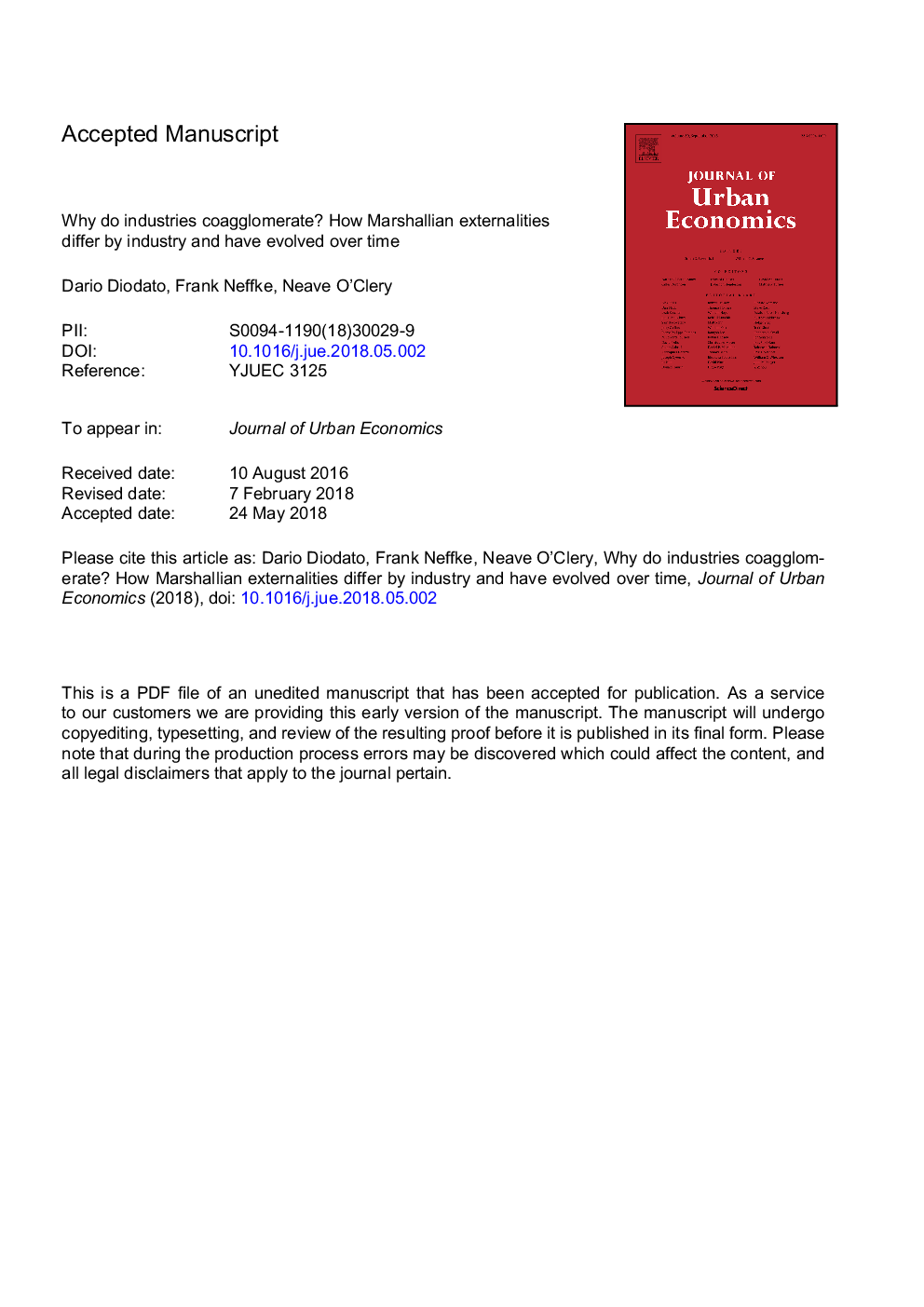| کد مقاله | کد نشریه | سال انتشار | مقاله انگلیسی | نسخه تمام متن |
|---|---|---|---|---|
| 9953056 | 1479646 | 2018 | 55 صفحه PDF | دانلود رایگان |
عنوان انگلیسی مقاله ISI
Why do industries coagglomerate? How Marshallian externalities differ by industry and have evolved over time
ترجمه فارسی عنوان
چرا صنایع همکاری می کنند؟ چگونه اثرات خارجی مارشال بر صنعت متفاوت است و در طول زمان تکامل یافته است
دانلود مقاله + سفارش ترجمه
دانلود مقاله ISI انگلیسی
رایگان برای ایرانیان
ترجمه چکیده
این واقعیت که شرکت ها از نزدیکی نزدیک به دیگر شرکت هایی که می توانند از ورودی، نیروی کار ماهر یا دانش فنی استفاده کنند، بهره مند شوند، توضیح می دهند که چرا بسیاری از خوشه های صنعتی بسیار موفق هستند. با بررسی تکامل الگوهای همگروهی، ما نشان می دهیم که نوع زراعت که به نفع شرکت ها در طی یک قرن تغییر کرده است و به طور قابل توجهی در صنایع متفاوت است. در عین حال، در ابتدای قرن بیستم، صنایع تمایل داشتند با شرکای زنجیره ارزش خود محصور شوند، در دهه های اخیر اهمیت این کانال کاهش یافته است و به نظر می رسد که کلکسیون از طریق شباهت در الزامات مهارت های صنایع بیشتر شده است. با محاسبه نیروهای متشکل از صنعت مارشال، می توانیم نشان دهیم که امروزه به اشتراک گذاری مهارت ها یکی از مهم ترین انگیزه های انتخاب خدمات محل می باشد، در حالی که ارتباطات ارزش زنجیره ای هنوز هم بسیاری از الگوهای رنگ آمیزی را در تولید توضیح می دهند. علاوه بر این، مقادیر تخمین زده شده که ارتباطات نیروی کار و ورودی-خروجی در شکلگیری هماهنگی صنعت منعکس شده است، به بهبود پیش بینی رشد اشتغال در صنعت شهر کمک می کند.
موضوعات مرتبط
علوم انسانی و اجتماعی
اقتصاد، اقتصادسنجی و امور مالی
اقتصاد و اقتصادسنجی
چکیده انگلیسی
The fact that firms benefit from close proximity to other firms with which they can exchange inputs, skilled labor or know-how helps explain why many industrial clusters are so successful. Studying the evolution of coagglomeration patterns, we show that the type of agglomeration that benefits firms has drastically changed over the course of a century and differs markedly across industries. Whereas, at the beginning of the twentieth century, industries tended to colocate with their value chain partners, in more recent decades the importance of this channel has declined and colocation seems to be driven more by similarities in industries' skill requirements. By calculating industry-specific Marshallian agglomeration forces, we are able to show that, today, skill-sharing is the most salient motive behind the location choices of services, whereas value chain linkages still explain much of the colocation patterns in manufacturing. Moreover, the estimated degrees to which labor and input-output linkages are reflected in an industry's coagglomeration patterns help improve predictions of city-industry employment growth.
ناشر
Database: Elsevier - ScienceDirect (ساینس دایرکت)
Journal: Journal of Urban Economics - Volume 106, July 2018, Pages 1-26
Journal: Journal of Urban Economics - Volume 106, July 2018, Pages 1-26
نویسندگان
Dario Diodato, Frank Neffke, Neave O'Clery,
